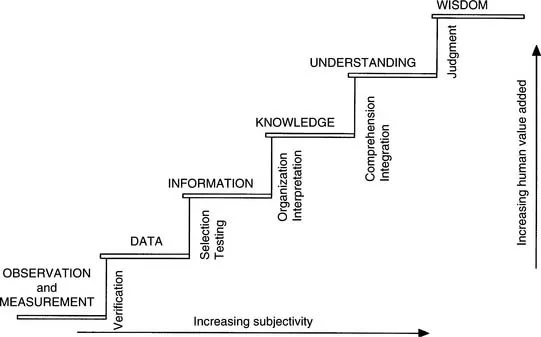THE ENVIRONMENT
Environmental changes occur naturally and are a part of or the result of multiple cycles and interactions. Numerous natural cycles of the earth’s environment have been studied within the framework of three major scientific disciplines: chemistry, physics, and biology. Environmental scientists study the dynamics of cycles, such as the nitrogen and water cycles, and their relationships to soil-geologic materials, surface waters, the atmosphere, and living organisms. The untrained observer may see the atmosphere as being separated from the earth’s surface. However, to the trained observer the environment is composed of integrated and interconnected cycles and domains. We now know that the environment is a continuum of physical, chemical, and biological processes that cannot be easily separated from one another. Water, for example, exists in three states and is found inside and on the surface of earth’s crust, in the atmosphere, and within living organisms. It is difficult to separate the physical, chemical, and biological processes of water within any particular environment, because water is transferred across boundaries.
Humans now have a more holistic view of the environment and recognize that many factors determine its health and preservation. This in turn has led to the new term biocomplexity, which is defined as “the interdependence of elements within specific environmental systems, and the interactions between different types of systems.” Thus, research on the individual components of environmental systems provides limited information on the system itself. We are now also concerned with sustainable and renewable versus non-renewable natural resources as well as with biodiversity in relation to our own survival.
ENVIRONMENTAL MONITORING
Environmental monitoring is the observation and study of the environment. In scientific terms, we wish to collect data from which we can derive knowledge (Figure 1.1). Thus, environmental monitoring has its role defined in the first three steps of the staircase and is rooted in the scientific method. Objective observations produce sound data, which in turn produce valuable information. Information-derived knowledge usually leads to an enhanced understanding of the problem/situation, which improves the chances of making informed decisions. However, it is important to understand that other factors, including political, economic, and social factors, influence decision making.
The information generated from monitoring activities can be used in a myriad of ways, ranging from understanding the short-term fate of an endangered fish species in a small stream, to defining the long-term management and preservation strategies of natural resources over vast tracts of land. Box 1.1 lists some recognizable knowledge-based regulations and benefits of environmental monitoring.
BOX 1.1 Knowledge-Based Regulation and Benefits of Environmental Monitoring
Protection of public water supplies: Including surface and groundwater monitoring; sources of water pollution; waste and wastewater treatment and their disposal and discharge into the environment
Hazardous, nonhazardous and radioactive waste management: Including disposal, reuse, and possible impacts to human health and the environment
Urban air quality: Sources of pollution, transportation, and industrial effects on human health
Natural resources protection and management: Land and soil degradation; forests and wood harvesting; water supplies, including lakes, rivers, and oceans; recreation; food supply
Weather forecasting: Anticipating weather, long- and short-term climatic changes, and weather-related catastrophes, including floods, droughts, hurricanes, and tornadoes
Economic development and land planning: Resources allocation; resource exploitation
Population growth: Density patterns, related to economic development and natural resources
Delineation: Mapping of natural resources; soil classification; wetland delineation; critical habitats; water resources; boundary changes
Endangered species and biodiversity: Enumeration of species; extinction, discovery, protection
Global climate changes: Strategies to control pollution emissions and weather- and health-related gaseous emissions
Although Box 1.1 is not exhaustive, it does give an idea of the major role that environmental monitoring plays in our lives. Many of us are rarely aware that such regulations exist and that these are the result of ongoing monitoring activities. Nonetheless, we all receive the benefits associated with these activities.
Recently, environmental monitoring has become even more critical as human populations increase, adding ever-increasing strains on the environment. There are numerous examples of deleterious environmental changes that result from population increases and concentrated human activities. For example, in the United States, the industrial and agricultural revolutions of the last 100 years have produced large amounts of waste by-products that, until the late 1960s, were released into the environment without regard to consequences. In many parts of the developing world, wastes are still disposed of without treatment. Through environmental monitoring we know that most surface soils, bodies of waters, and even ice caps contain trace and ultratrace levels of synthetic chemicals (e.g., dioxins) and nuclear-fallout components (e.g., radioactive cesium). Also, many surface waters, including rivers and lakes, contain trace concentrations of pesticides because of the results of agricultural runoff and rainfall tainted with atmospheric pollutants. The indirect effects of released chemicals into the environment are also a recent cause of concern. Carbon dioxide gas from automobiles and power plants and Freon (refrigerant gas) released into the atmosphere may be involved in deleterious climatic changes.
Environmental monitoring is very broad and requires a multi-disciplinary scientific approach. Environmental scientists require skills in basic sciences such as chemistry, physics, biology, mathematics, statistics, and computer science. Therefore, all science-based disciplines are involved in this endeavor.

